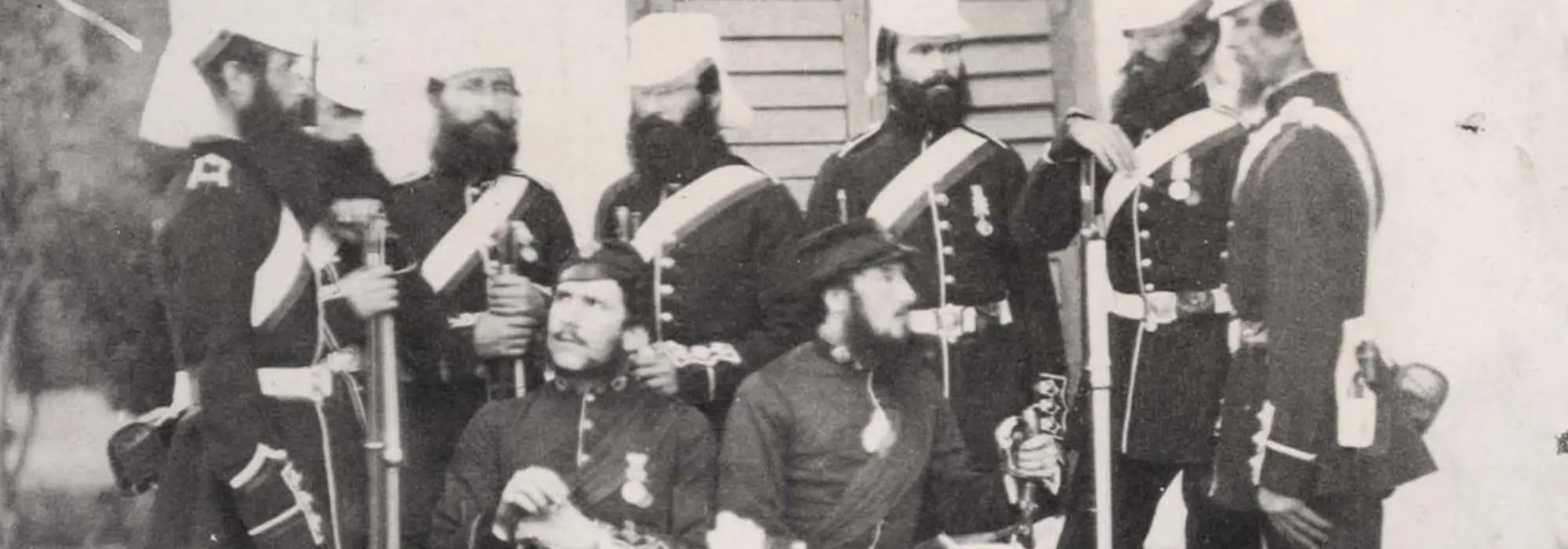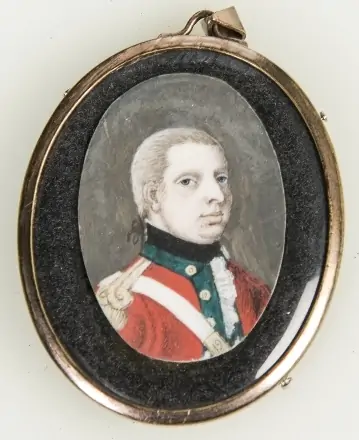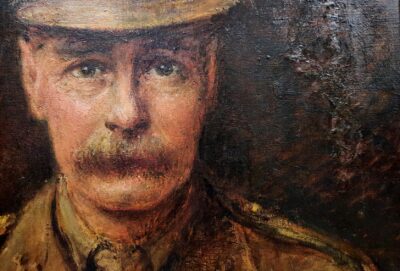
Hirsuit. Point and shoot!
Fashions for male facial hair wax and wane over time.
Our photograph collection contains some stunning examples of marvellous moustaches, brilliant beards and mind-blowing mutton chops. It appears the wearers of these facial adornments were only too happy to pose for the occasional portrait, so we’d like to share some of those images with you.
FACES, FASHION AND TECHNOLOGY
FRESH FACED GEORGIANS



Every man must appear as clean as his situation will allow, his Hands, Face, and Feet washed, and his Hair combed.
General Regulations and Orders for the Army 1811
FACIAL RECOGNITION

Charles Organ’s fabulous tash is shown to full effect in this image from the early 1900s. Find out about his equally impressive army career, and how it turns out this photo is only half of the story…

A bearded, moustachioed, mutton-chopped Paymaster Thomas Palmer, about 1898.

The beautifully quiffed hair of Lt Col James Ahmuty Fearon sits atop an equally fulsome moustache in this image from about 1898.

This image of Lt RH Atkinson was taken in 1871 and is from a photograph album in our collection, ‘Victorian Officers 1860-1900’.

During the 1930s moustaches became smaller, neater and more closely cropped, even starting to retreat inwards to fit beneath the nose. This trend was soon halted, for obvious reasons, on the outbreak of the Second World War. Frank Ainley’s moustache was sadly stopped in its tracks before this momentous world event. Find out more about him.

The 2nd Battalion’s Sergeant Brown has a shave in the desert, Egypt, 1954.

It’s not the facial fashions that tell us the date of this early image from the collection, but the uniform. Private Howell, who served with the regiment between 1837 and 1859, sports a single-breasted tunic. It was only worn for one year, in 1856.

This photo of the 5th Battalion’s 2Lt TH Gaunt having a shave in the spring 1916 in Redcar, is from an album belonging to 2Lt Geoffrey Smith.

Two veterans from the 1st Battalion. From Michael Ferrar’s photograph album (1892-1905).
The hair of the troops is, constantly and habitually, to be cut short, both at the top and sides of the head, according to the orders of the sovereign, and the fashion of the day is not to be permitted to influence the practice of the Army.
The Queen's Regulations and Orders for the Army 1844
FULL FACIAL
Soldiers were returning from the Crimean War in the mid 1850s with large beards, much to the delight of Queen Victoria who noted admiringly in her diary on 13 March 1856 that they were ‘the picture of real fighting men.’
Two years earlier it had been declared that troops of the East India Company must sport a moustache. Combined with Charles Dicken’s devotion to the beard; he’d written his manifesto, ‘Why Shave’ in 1853, it’s no wonder the portraits of soldiers serving with the regiment in the mid to late Victorian period are particularly hirsuit.

Lt Col Mundy, about 1898.

Lt Col Munro, about 1898.

General O’Grady Haly, about 1898.
CURRIE'S DRESSING CASE

As well as holding a razor and grooming equipment, this wooden dressing case belonging to Leonard Douglas Hay Currie features three boxes with decorated silver lids, buttons and three pieces of hair, folded in paper. The holdall itself was used by Currie whilst serving with the regiment in the Crimea in 1854. Leonard Currie had an extraordinary transatlantic career. Find out more about it here.
It was mandatory to ‘wear’ a moustache in the British Army between 1860 and 1916.
Apropos of ‘shaves’ a good tale comes to us from the Depot with the Draft. A recruit of two days’ service, having appeared unshaved on early parade, was ordered by his officer to perform the necessary operation before he went round the rooms at nine o’clock. The efforts of the Recruit were to a certain extent successful: but he was unacquainted with razors, and his face much resembled a meat ration when the officer visited the Barrack room. In these days of lectures such a golden opportunity of impressing a useful lesson could not be lost. Assembling the rest of the me, the Officer pointed out the ability of the Recruit; and thereupon appointed him Barber to the Company, to shave all men unable to shave themselves.
No man of that Company has turned out unshaven since then – they shave themselves.
The Green Howards Gazette, April 1894
upper lip conservation

John Lodge seemed destined for a life in law, having been called to the Bar in 1883. At 18, John had joined the 5th West York Militia, which later becomes the 3rd Battalion The Yorkshire Regiment. He serves in the 2nd Boer War (1899-1902) and is Battalion Commander from 1906 until retirement in 1912. A local Justice of the Peace when war breaks out in 1914, he returns to his old battalion as a Major. Find out how this wonderful portrait of Lodge, by Rowland Henry Hill, found its way into the museum’s collection here.
The highest state of efficiency and discipline can only be obtained by…constant attention to minute details, which though apparently unimportant, can never be neglected without injury to the system of which they form a part, and to the character of the individual who neglects his duty.
'Officer's Generally' section of The King's Regulations and Orders for the Army 1909
blade amongst remains

The fragile shards of a shaving razor are among the objects, including a belt buckle, ammunition, buttons and badges found on the body of an un-identified soldier in the Somme battlefields.
Our research helped piece together the events of almost 100 years ago to discover who he was.
a hero's razor

Our collection contains two objects belonging to David Hirsch, who served with the regiment during the First World War.
One is a set of medals, including Hirsch’s Victoria Cross, which you can see on display in the museum’s Medal Room.
The other is his razor.
The hair of the head is to be kept short. The chin and under-lip will be shaved. Whiskers, if worn, will be of moderate length.
Kings Regulations and Orders 1935 - para 978, section X Dress, Clothing, Equipment, Medals and Decorations
LONG SERVICE AND GOOD CUTTING
Unique amongst our collection is a small pamphlet, published in 1948, printed in Chelsea by JB Shears, which seems appropriate considering the subject matter.
It’s a volume of testimonials for Jan Mohammed & Sons, ‘Master Barbers and Tailors to the 2nd Bn The Green Howards, Peshawar’, collected over 43 years and containing endorsements from a range of civilians and servicemen, many of them from the regiment.
One of the earliest endorsements comes from DW Vanrenen in October 1901. He says, “Jan Mohammed has been doing barber’s work for me for a year, and I have been entirely satisfied with him. He gives on an excellent cut of hair.”
The last is from the Officer Commanding The Green Howards’ 2nd Battalion, Lt Col FEA MacDonnell, who wrote from Barrackpore in October 1947, “It gives me great pleasure to have the honour to write the last of the testimonials for surely this will be the last. Some Indians, Jan Mohammed for one, are sad at our departure, as indeed we are to bid them farewell. Jan Mohammed has been associated with The Green Howards for over 30 years, as his many testimonials show. I have only been able to engage him recently, he has had to accept an extremely low contract, nevertheless he has given of his best. may he prosper in his Pakistan and look back with mutual esteem on us Green Howards.”

Company Sergeant Major George Badger, Regimental Sergeant Major Bill Curtis, Lt General Sir Richard Hull (Chief of the General Staff) in Iserlohn, Germany about 1961. Bill enlisted at Richmond in 1940. His 22 years career saw him serve in Malaya and Germany.
The 1960s counter culture saw beards enjoy a resurgence, but the smart, groomed moustache remained popular amongst serving personnel throughout the decade.
THE MAGNUM EFFECT

Tom Selleck's Magnum PI 'chevron' moustache became popular in the 1980s, including with several of the 1st battalion's triumphant boxers, photographed in 1983 after beating the Royal Tank Regiment.

One of the few roles where a beard on parade is acceptable. Pioneer Sergeants, in this case Pioneer Sergeant JC Pledger, have existed since the 1700s when every infantry regiment would have a ‘pioneer’ who would march ahead. He would wear a ‘stout’ apron to protect his uniform and carry an axe to clear the path for those following.

Meanwhile in Afghanistan, WO2 Benson’s authentic sand camouflage can’t conceal his beard.
If a moustache is worn, it is to be trimmed and not below the line of the lower lip. Beards and whiskers are only to be worn with the CO’s authority, which will usually be granted only on medical or religious grounds, or where tradition permits. The appearance of the beard and whiskers is to be neat and tidy. Sideburns are not to descend below the mid-point of the ear and are to be trimmed horizontally.
Queen's Regulations 2021
What next? We may see beards as bushy as those worn in the Crimea, a waxed handlebar moustache or even the resurgence of the mutton chop. Fashion, cultural inclusivity, rules, regulations and operational circumstances will influence and dictate the future face of the fighting force.
This online exhibition is just one strand of the work we do to bring our collection to you, wherever you may be. Use the boxes below to sign up for occasional museum news direct to your inbox, and make a donation to help support our work.
